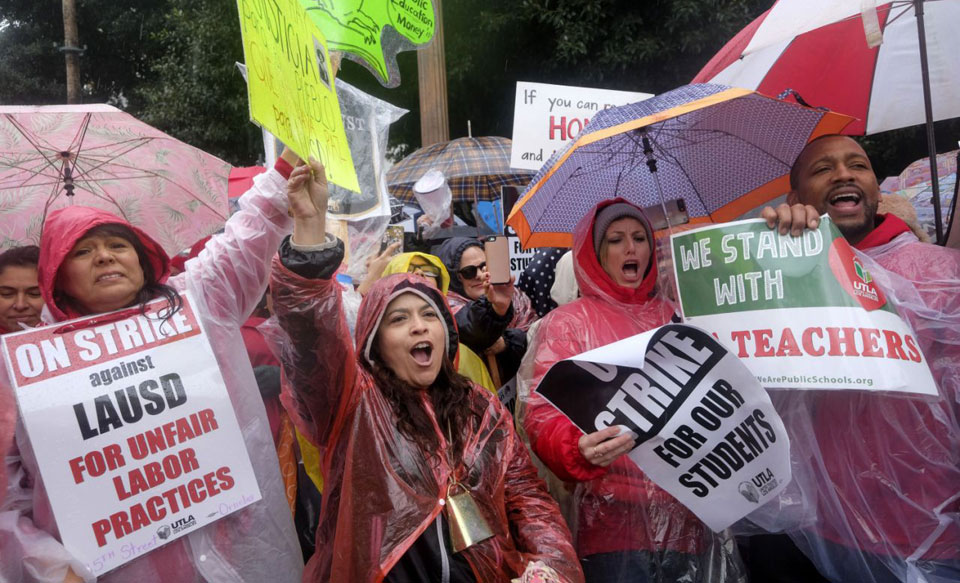
WASHINGTON—Union membership declined slightly from 2017 to 2018, the Bureau of Labor Statistics reported. Using calculations from the Current Population Survey – a scientifically selected rolling sample of 60,000 households – BLS calculated there were 14.744 million union members last year, down 73,000 from the year before. Union density in 2018 was 10.5 percent
Anticipating the numbers, the AFL-CIO vigorously countered by citing union victories last year and this: The 30,000 teachers forced to strike in Los Angeles this week.
“Here’s what the numbers alone won’t tell you: 2018 was one of the most substantial years for collective action in American history,” federation spokesman Josh Goldstein said.
Besides the L.A. teachers, he cited Unite Here workers “taking on Marriott” – and winning – over the issue of low-paying jobs and Google workers walking out worldwide over issues of sexual harassment and a voice on the job. The Google workers are not unionized.
And while Goldstein didn’t say so, BLS added another union edge: Pay. And pay equity. The median union worker earned $1,051 weekly last year, compared to $860 for the median non-unionist. The median is the point where half of the workers are above and half below.
Median weekly earnings for union men were $1,123, $175 ahead of non-union men ($948). Median weekly earnings for union women were $968, 86 percent of the earnings of union men.
Median weekly earnings for union women last year were $20 more than those of non-union men, and $234 more than the median for non-union women. Non-union women earned 80.5 percent of what non-union men did.
Goldstein also cited unions’ record – and successful – political activism, including election of a pro-worker majority in the U.S. House and of 950 unionists who won political office in November, from Gov. Tim Walz, DFL-Minn., an Education Minnesota member on down to a Teamster win in a rural county commissioner’s seat in rural North Carolina.
All of that contrasts with BLS’ numbers.
The agency reported that a slight majority of union members were in the private sector, 7.577 million, compared to 7.167 million in the public sector.
The public sector was more heavily unionized, with one of every three workers – state and local government workers, teachers, firefighters, and federal workers – unionized, compared to one of every 16 (6.4 percent) in the private sector. Teachers and protective services, each with even higher percentages, led the way.
The construction industry told BLS surveyors they had 1.048 million union members last year, down 54,000 from 2017. One of every eight construction workers was a unionist.
Factories added 12,000 more unionized workers in 2018, to 1.34 million, BLS calculated. The factory numbers imply the gains may have come from signing up former “free riders.” Their numbers in factories dropped by 17,000 last year.
Overall, the number of people represented by unions, including both union members and workers represented by unions but who are not members – the “free riders,” especially in right-to-work states – declined by 64,000, the agency said.
As usual, union members were concentrated in the Northeast, the Great Lakes, and the Pacific Coast states. The most union-dense states last year were Hawaii (23.1 percent), New York (22.3 percent), Washington (19.8 percent), Alaska (18.5 percent) and Rhode Island (17.5 percent).
The biggest union numbers BLS calculated were in California (2.405 million, down 87,000 and with 14.7 percent density), New York (1.872 million, -145,000, 22.3 percent), Illinois (786,000, -86,000, 13.8 percent), Pennsylvania (701,000, +36,000, 12.6 percent), Michigan (625,000, -33,000, 14.5 percent), Ohio (639,000, +4,000, 12.6 percent) and Washington (649,000, +61,000, 19.8 percent).
Washington’s numerical gain was so large that it pushed New Jersey, which lost members, out of the top seven, the first such change in those ranks in at least a decade.
Washington was also the biggest numerical gainer, but BLS calculated many of the other gains were in the least-unionized area, the South. Florida (+38,000), Georgia and Alabama (+28,000 each), Louisiana (+11,000) and South Carolina (+3,000) all added union members.










